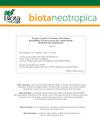Relative condition factor and predictive model for the presence of the invasive snail Achatina (Lissachatina) fulica in Sergipe, Northeast Brazil
IF 1.2
4区 环境科学与生态学
Q3 BIODIVERSITY CONSERVATION
引用次数: 3
Abstract
Abstract: Achatina fulica is among the world’s 100 most impactive invasive species, and is now found in almost all Brazilian states, including Sergipe. This exotic snail is known to have negative impacts, not only on the environment, due primarily to the rapid growth of its populations, but also on public health, given that it is an intermediate host of nematodes that cause zoonotic diseases. However, relatively little is known of the development of this snail, including its relative condition factor. We investigated the occurrence of A. fulica in 24 municipalities distributed in the eight subregions of the state of Sergipe in the dry and rainy season. Furthermore, we present here a predictive model for the occurrence of A. fulica based on the variation in climate and soil chemistry. This snail was more frequent on soils with a pH of 6.5-7.5. A negative correlation was found between the growth of A. fulica and the soil pH, then, the more acidic the soil, the more allometric the growth of A. fulica. The relative condition factor indicated differences in the development pattern of A. fulica among the eight subregions. The influence of rain in increasing the frequency of A. fulica showed a significant correlation. As well, higher temperatures influenced the resting behavior of A. fulica. The mathematical model used to identify the potential presence of A. fulica presented a high degree of agreement. This is the first ecological study of A. fulica to verify the association between the body mass-length relationship and the relative condition factor, and the results indicate that the development of this exotic land snail in Sergipe is influenced by climatic factors and principally, the soil pH. The predictive mathematical model provides valuable insights into the biotic and abiotic factors associated with the presence of A. fulica, and the influence of climatic variables and the chemical parameters of the soil on the occurrence of this species. These findings provide important guidelines for the development of measures for the control of A. fulica populations, which will contribute to both public and environment health.巴西东北部Sergipe地区入侵蜗牛黄斑螺(Lissachatina)存在的相关条件因子及预测模型
摘要/ Abstract摘要:fulica是世界上100个最具影响力的入侵物种之一,目前在巴西包括Sergipe在内的几乎所有州都有发现。众所周知,这种外来蜗牛不仅对环境有负面影响(主要是由于其种群的快速增长),而且对公共卫生也有负面影响(因为它是引起人畜共患疾病的线虫的中间宿主)。然而,对这种蜗牛的发育,包括它的相对条件因素,所知相对较少。我们调查了分布在塞尔吉佩州8个分区的24个市在旱季和雨季的黄颡鱼发生情况。在此基础上,我们建立了基于气候和土壤化学变化的黄颡鱼发生预测模型。这种蜗牛在pH值为6.5-7.5的土壤中更常见。黄颡鱼的生长与土壤pH呈负相关,土壤越酸,黄颡鱼的异速生长越快。相对条件因子显示了8个亚区黄颡鱼发育模式的差异。降雨对黄颡鱼发生频率的影响呈显著相关。此外,较高的温度也会影响黄颡鱼的静息行为。用数学模型来鉴定黄芽孢杆菌的潜在存在表现出高度的一致性。本研究首次验证了黄颡鱼体长关系与相关条件因子之间的关系,结果表明,Sergipe地区黄颡鱼的发育受气候因素的影响,主要受土壤ph的影响。该预测数学模型为了解黄颡鱼存在的生物和非生物因素提供了有价值的见解。气候变量和土壤化学参数对该物种发生的影响。这些发现为制定控制黄颡鱼种群的措施提供了重要的指导方针,这将有助于公共卫生和环境卫生。
本文章由计算机程序翻译,如有差异,请以英文原文为准。
求助全文
约1分钟内获得全文
求助全文
来源期刊

Biota Neotropica
BIODIVERSITY CONSERVATION-
CiteScore
2.90
自引率
16.70%
发文量
0
审稿时长
4-8 weeks
期刊介绍:
BIOTA NEOTROPICA is an electronic, peer-reviewed journal edited by the Program BIOTA/FAPESP: The Virtual Institute of Biodiversity. This journal"s aim is to disseminate the results of original research work, associated or not to the program, concerned with characterization, conservation and sustainable use of biodiversity within the Neotropical region.
Manuscripts are considered on the understanding that their content has not appeared, or will not be submitted, elsewhere in substantially the same form, because once published their copyrights are transferred to BIOTA NEOTROPICA as established in the Copyright Transfer Agreement signed by the author(s).
 求助内容:
求助内容: 应助结果提醒方式:
应助结果提醒方式:


